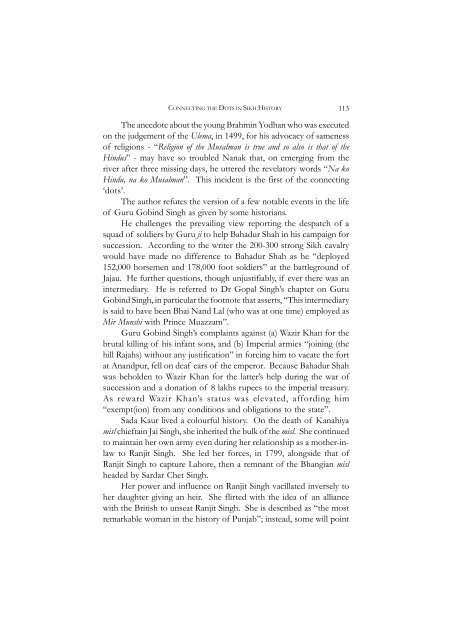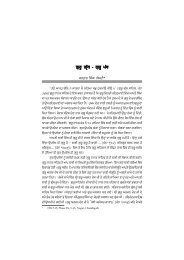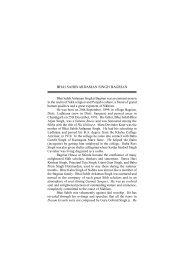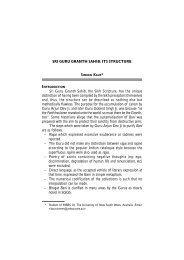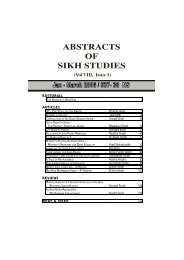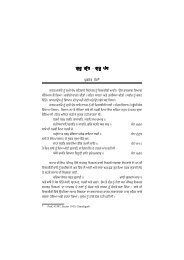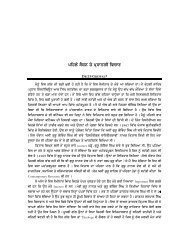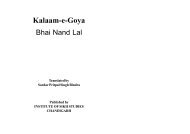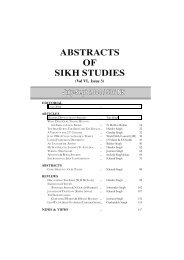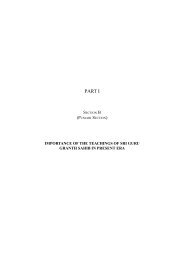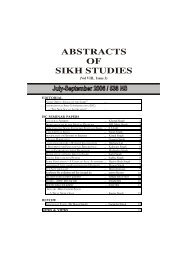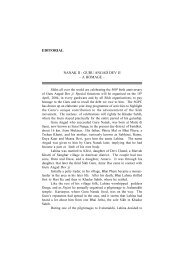editorial articles reviews news & views - Institute of Sikh Studies
editorial articles reviews news & views - Institute of Sikh Studies
editorial articles reviews news & views - Institute of Sikh Studies
Create successful ePaper yourself
Turn your PDF publications into a flip-book with our unique Google optimized e-Paper software.
CONNECTING THE DOTS IN SIKH HISTORY<br />
113<br />
The anecdote about the young Brahmin Yodhan who was executed<br />
on the judgement <strong>of</strong> the Ulema, in 1499, for his advocacy <strong>of</strong> sameness<br />
<strong>of</strong> religions - “Religion <strong>of</strong> the Musalman is true and so also is that <strong>of</strong> the<br />
Hindus” - may have so troubled Nanak that, on emerging from the<br />
river after three missing days, he uttered the revelatory words “Na ko<br />
Hindu, na ko Musalman”. This incident is the first <strong>of</strong> the connecting<br />
‘dots’.<br />
The author refutes the version <strong>of</strong> a few notable events in the life<br />
<strong>of</strong> Guru Gobind Singh as given by some historians.<br />
He challenges the prevailing view reporting the despatch <strong>of</strong> a<br />
squad <strong>of</strong> soldiers by Guru ji to help Bahadur Shah in his campaign for<br />
succession. According to the writer the 200-300 strong <strong>Sikh</strong> cavalry<br />
would have made no difference to Bahadur Shah as he “deployed<br />
152,000 horsemen and 178,000 foot soldiers” at the battleground <strong>of</strong><br />
Jajau. He further questions, though unjustifiably, if ever there was an<br />
intermediary. He is referred to Dr Gopal Singh’s chapter on Guru<br />
Gobind Singh, in particular the footnote that asserts, “This intermediary<br />
is said to have been Bhai Nand Lal (who was at one time) employed as<br />
Mir Munshi with Prince Muazzam”.<br />
Guru Gobind Singh’s complaints against (a) Wazir Khan for the<br />
brutal killing <strong>of</strong> his infant sons, and (b) Imperial armies “joining (the<br />
hill Rajahs) without any justification” in forcing him to vacate the fort<br />
at Anandpur, fell on deaf ears <strong>of</strong> the emperor. Because Bahadur Shah<br />
was beholden to Wazir Khan for the latter’s help during the war <strong>of</strong><br />
succession and a donation <strong>of</strong> 8 lakhs rupees to the imperial treasury.<br />
As reward Wazir Khan’s status was elevated, affording him<br />
“exempt(ion) from any conditions and obligations to the state”.<br />
Sada Kaur lived a colourful history. On the death <strong>of</strong> Kanahiya<br />
misl chieftain Jai Singh, she inherited the bulk <strong>of</strong> the misl. She continued<br />
to maintain her own army even during her relationship as a mother-inlaw<br />
to Ranjit Singh. She led her forces, in 1799, alongside that <strong>of</strong><br />
Ranjit Singh to capture Lahore, then a remnant <strong>of</strong> the Bhangian misl<br />
headed by Sardar Chet Singh.<br />
Her power and influence on Ranjit Singh vacillated inversely to<br />
her daughter giving an heir. She flirted with the idea <strong>of</strong> an alliance<br />
with the British to unseat Ranjit Singh. She is described as “the most<br />
remarkable woman in the history <strong>of</strong> Punjab”; instead, some will point


